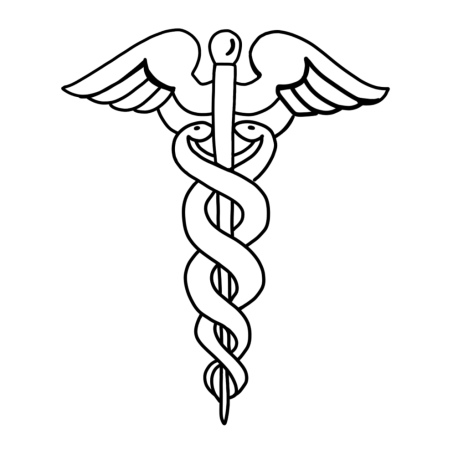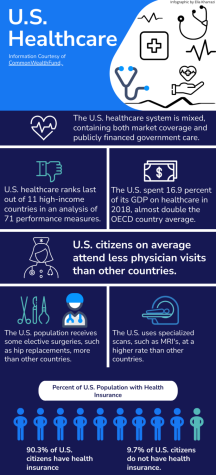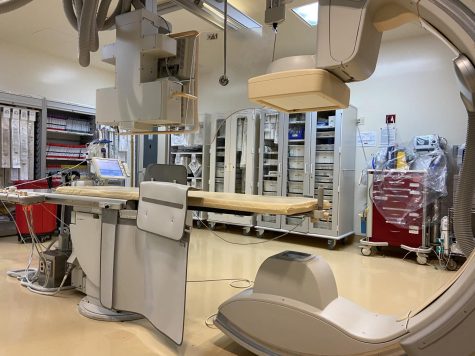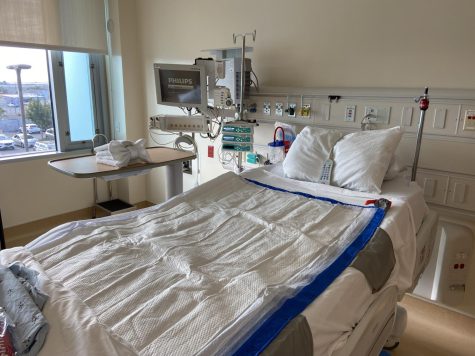Today, the U.S. healthcare system provides patient care through both out-of-pocket payments and market provision of coverage, combining various traditional healthcare systems. The federal government also offers public forms of insurance such as Medicare and Medicaid, with Medicare issuing health coverage to those over the age of 65 and people who qualify for Social Security Disability benefits, and Medicaid covering eligible persons of low-income. Despite these programs, 9.7 percent of Americans and 4.2 percent of Marin County residents lacked health insurance in 2020, requiring them to pay for healthcare out of pocket.

Although the Tamalpais Union High School District provides “a fully-paid health benefits package to certificated staff who work at least 60 percent of full time and to classified staff who work at least 30 hours per week,” many jobs do not provide coverage. Medicaid is not expanded in every state, and 73.7 percent of uninsured adults in 2019 stated that the reason for their uninsurance was the high cost of coverage. Unlike several progressive countries such as France, Germany, andSwitzerland, the U.S. has an absence of universal health coverage, or, according to the World Health Organization, “[provision of] access to the health services people need, when and where they need them, without financial hardship.”
The Fee-for-Service and Capitation Care Methods
Fee-for-service healthcare is the traditional payment system in the U.S. and is a system in which healthcare is monetized. Each service for patients, such as surgeries and scans, has a set payment amount, and healthcare providers are paid in this way.
Although common in the U.S., the fee-for-service method is not without faults. Public Health Officer of Marin Matt Willis recognizes the downfalls of this system and its inherent motivating techniques.
“I think the problem is that when you monetize treatment for illness rather than health and wellbeing and the prevention of illness, you’re barking up the wrong tree right off the bat,” Willis said. “[Doctors, nurses and healthcare systems] are incentivized to charge for their services as much as they can because that is how profit is gained.”

This aspect of monetizing healthcare leads to inequality for lower-income citizens. Although public insurance such as Medicare and Medicaid covers costs, Willis states that doctors will pursue higher compensation if offered, rather than take potentially lower payments from public insurance.
“It is really hard sometimes to find a specialist who will actually see a patient who has public insurance because that insurance will pay less for that service. Doctors will prioritize patients for which they get higher rates of payment,” Willis said.
Robert Pearl, the former Chief Executive Officer of The Permanente Medical Group, the largest medical group in the U.S., compares the majority of the American healthcare system to a 19th-century cottage industry. Like Willis, he suggests that doctors in the U.S. healthcare system often work in their own best interest.
“Doctors are fragmented — they work in their own offices and they are not connected. They are paid in a piecemeal system. Everyone makes decisions that are best for themselves, which is far less positive for the overall healthcare system and most importantly, far less positive for patients,” Pearl said.
For example, recent studies in the past 10 years have shown that knee arthroscopy surgery for meniscal tears and osteoarthritis, which can cost as much as $10,000, produces the same if not worse outcomes than nonsurgical treatment such as physical therapy. Knee arthroscopy surgery is extremely common, with approximately 750,000 operations in the U.S. per year, costing around $4 billion. Despite these studies, the number of knee arthroscopy surgeries performed has not declined since the research was published.
However, select companies such as Kaiser Permanente operate on a capitation system. Capitation, a form of prepayment, involves paying a certain amount each month to the group of physicians that is caring for a population of patients. The payment quantity is based on the patient’s prospect to develop a complication or require specific medical attention. Often referred to as “pay for value,” the capitation approach focuses more on prevention compared to the fee-for-service method. Pearl accentuates this distinction between the systems.
“Capitation versus fee-for-service predominantly relates to incentives and the motivation that doctors find themselves in. This is based upon how much money they are going to earn as a consequence of whether they are paid to do simply more things or help patients avoid complications such as a heart attack,” Pearl said. “Obviously you do better economically in a capitated system because you have been paid the money to take care of the patient and you do not have to spend the money taking care of the heart attack.”
The challenge to a capitation system is that there is fear that doctors will not perform high quality care if they are not paid per service they provide. Despite this obstacle, Kaiser Permanente, an American healthcare provider, which operates on a capitation system, is among the highest-rated quality programs in the nation, according to the National Committee for Quality Assurance.
“The data would say that the capitation method not only allows physicians to provide excellent quality but to also do an even better job because they have higher performance in areas such as preventing disease, avoiding complications and minimizing medical errors,” Pearl said.
The U.S. Compared to Other Countries
According to a 2019 analysis of health data from the Organization for Economic Co-operation and Development (OECD), which compiles information on various aspects of healthcare in 36 high-income countries, the U.S. spends almost twice as much of its gross domestic product on health care than the OECD average. Despite its high spending, when compared with 11 high-income countries, the U.S. ranks last overall in multiple areas of study. For example, the U.S. had the lowest life expectancy and one of the highest rates of hospitalizations for diabetes and hypertension, conditions considered preventable if provided adequate primary care. Similarly, people in the U.S. on average attend fewer physician visits than in the 11 countries studied, but use expensive technologies and surgeries more frequently. This indicates that while U.S. spending is greater than other countries, citizens are not receiving proportionally high levels of care.

Critical care physician at the University of Toronto and Director of Clinical Epidemiology and Health Care Research at the Dall Lana School of Health Policy Rob Fowler highlights possible reasons why U.S. healthcare may cost more than a country with universal nationalized healthcare.
“I think the simplified difference [between the cost of healthcare in the U.S. and other countries] is the prices because the prices will get put up to the amount that the market will bear,” Fowler said. “The prices for things seem to be higher across the board in the U.S., and in part, I think they are higher because the prices are passed from the provider to the insurance company and then on to the employer or the person paying for it.”
A 2018 study from the Harvard T.H. Chan School of Public Health at Harvard University and the London School of Economics supports Fowler’s claim, concluding that the largest contributor to expensive healthcare in the U.S. is high prices when prices are “unjustified markups on goods and services by drug and device companies, insurance companies and hospitals.”
Canada differs from the U.S. in that most healthcare is covered by taxes and administered by the government as a single provider and payer. In contrast, the U.S. contains several different healthcare providers, and it is generally necessary to have insurance to cover the costs. Fowler identifies how the Canadian universal healthcare system places less stress on its population.
“No one thinks about the cost of health being a big financial burden [in Canada]. For most of the population, people don’t worry about not being able to cover healthcare costs,” Fowler said.
On the contrary, the disparities in the U.S. healthcare system are prominent. Willis further emphasizes the inequalities due to the lack of universal coverage for people of low income.

“The most glaring gap is how people of low income are treated. Thankfully, most of us in Marin County are relatively buffered from the reality that many Americans of low income simply do not have access to high-quality healthcare,” Willis said. “From a health equity standpoint or from a moral standpoint, it is really unacceptable.”
Although there is no simple solution to completely remedy the U.S. healthcare system, Pearl offers potential ways to mitigate the harm it causes and the disparities it fosters.
“Congress could pass legislation that would change Medicare and could fix it, businesses could demand that insurers offer only capitation products and businesses could say that they will not work with doctors who are not integrated,” Pearl said. “The biggest challenge is making those changes happen. It is very unclear whether anyone will step forward to improve what is now a very broken system that has been around for decades.”








